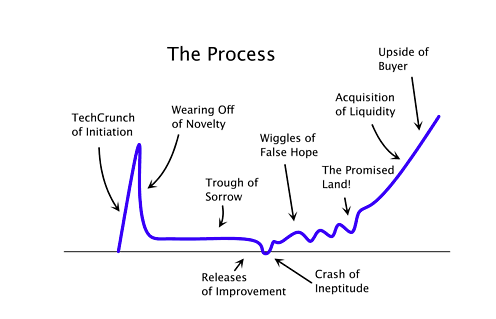Normal is getting dressed in clothes that you buy for work and driving through traffic in a car that you are still paying for – in order to get to the job you need to pay for the clothes and the car, and the house you leave vacant all day so you can afford to live in it.
-Ellen Goodman
Obama: a man, or an idea?
I would never have thought, graduating college in 2006 with the Bush years in full swing, that we would be only two years away from Democrat control of the presidency for two full terms.
The election yesterday was important because it was a rejection of the repugnant brand of conservatism that argues government should have no ambition beyond self-immolation and individuals should have no ambition beyond themselves.
Obama is a flawed leader, but he is a deft politician. He has managed to win a national debate about a moral truth in society. One newspaper declared, “A Liberal America”, but it’s more like “A Mixed Economy America”.
Dark Money Rises
This is the most important post to read this election cycle. Thanks to ProPublica’s liberal terms, I can re-publish it in its entirety here. I’ve also included links to the excellent interactive features at the end of the story.
Orignal authorship:
Michael Scherer, TIME Nov. 1, 2012, 7 a.m.
Justin Elliott, ProPublica, Nov. 1
Kim Barker, ProPublica, Nov. 1
This post was co-published with TIME. It originally appeared on ProPublica.
About a week before election day, a young girl, maybe 10 years old, confronted Colorado House candidate Sal Pace in a pew at his Pueblo church. “She said, ‘Is it true that you want to cut my grandmother’s Medicare?'” Pace remembers.
Like many other Democrats around the country, Pace has spent months trying to rebut the charge that President Obama’s health care reforms hurt Grandma by cutting Medicare by $716 billion. In fact, the same cuts in payments to medical providers found in Obamacare can also be found in the House Republican budget, and they do not directly limit patient care. “I told the little girl that the ads are full of lies and that it’s not right for people to lie,” he said.
What Pace couldn’t tell the girl was who exactly is to blame. That’s because the moneymen behind the outfit spending the most on the Medicare attack ads in Pace’s district will not show their faces. The money is being spent through a Washington-based group, Americans for Tax Reform (ATR), that calls itself a “social welfare” nonprofit, so it does not need to reveal its donors to the public. In mid-October, the group popped up in Pace’s district, which is about the size of New York state, and promised to spend $1.3 million there in the campaign’s final three weeks. In one day, Pace spokesman James Dakin Owens said, “They basically matched us dollar for dollar for everything we had raised in the campaign. It was an 800-pound gorilla that just jumped in.”
The Future of News… in 1992
Just came across this article from Recovering Journalist discussing A Vision for the Future of Newspapers — 20 Years Ago.
Bob Kaiser, an editor of the Washington Post, wrote the following memo to his colleagues in 1992, forecasting (mostly correctly) the next 20 years in computing, the changing content ecosystem, and the remaining role for editors:
Why Startups Die
Startups die due to a variety of causes. Over the course of the last three years, I’ve watched many of my friends pour their hearts and souls into companies that, for one reason or another, just fizzled out of existence.
In 2007, Paul Graham gave a variety of causes for startup death in How Not To Die. He wrote:
When startups die, the official cause of death is always either running out of money or a critical founder bailing. Often the two occur simultaneously. But I think the underlying cause is usually that they’ve become demoralized. You rarely hear of a startup that’s working around the clock doing deals and pumping out new features, and dies because they can’t pay their bills and their ISP unplugs their server.
The other major thing Graham advises startups not to do: “other things”. Namely:
[D]on’t go to graduate school, and don’t start other projects. Distraction is fatal to startups. Going to (or back to) school is a huge predictor of death because in addition to the distraction it gives you something to say you’re doing. If you’re only doing a startup, then if the startup fails, you fail.
In early 2011, I wrote a post, Startups: Not for the faint of heart, that discussed Parse.ly’s survival through a one-year bootstrapping period after Dreamit Ventures Philly ’09. Since then, I’ve witnessed yet more startup deaths, and especially extended “troughs of sorrow”.

As a result, I’ve had a kind of mild survivor guilt, and have started to look for patterns in causes in the deaths I have witnessed.
Reporting is not enough
A great article came out today in INMA entitled, “Industry metrics: Is it time to say goodbye to the pageview?”.
In it, the authors write:
Reporting is sufficient for showing whether or not we had a good month, but not insightful enough to tell us what we were doing right, where we went wrong, and what we might replicate and discard to perform better in the next reporting period.
Relying exclusively on the pageview — an important and dominant metric in online media — leads to some startling conclusions.
Information fanaticism
On finding alternative sources of news in the pre-web era (this quote comes from ~1992):
The information is there, but it’s there to a fanatic, you know, somebody wants to spend a substantial part of their time and energy exploring it and comparing today’s lies with yesterday’s leaks and so on. That’s a research job and it just simply doesn’t make sense to ask the general population to dedicate themselves to this task on every issue.
[…]
Very few people are going to have the time or the energy or the commitment to carry out the constant battle that’s required to get outside of MacNeil/Lehrer or Dan Rather or somebody like that. The easy thing to do, you know — you come home from work, you’re tired, you’ve had a busy day, you’re not going to spend the evening carrying on a research project, so you turn on the tube and say, “it’s probably right”, or you look at the headlines in the paper, and then you watch the sports or something.
That’s basically the way the system of indoctrination works. Sure, the other stuff is there, but you’re going to have to work to find it.
The End of PowerPoint
Edward Tufte is the father of modern information visualization. If you don’t know who he is, you probably should, and you can get up to speed by reading this profile in Washington Monthly, The Information Sage.
Last year, I attended one of Tufte’s one-day courses in NYC. I even showed him an early, prototype version of Parse.ly Dash. His feedback — even if it came quickly in 5 minutes — was helpful in understanding how to move the product forward.
I thought, when attending his presentation, that my main takeaways would be in the field I associated with him, namely, information visualization. But actually, my main takeaways were about communication, teaching, and journalism.
Fully distributed teams: in lists
Things fully distributed teams need:
- real-time chat
- hosted code repos and code review
- async updates
- email groups
- basic project management
- bug / issue tracking
- customer support tools
- easy way to share files
- standard way to collaborate on documents and drawings
- personal task lists
- personal equipment budgets
- wiki
- team calendar
- webcams (caution: use sparingly)
Things fully distributed teams are happy to live without:
- constant interruptions
- long commutes
- “brainstorming sessions”
- all-hands meetings
- equipment fragmentation
- slow, shared internet
- 9-to-5
- “that guy”
Things fully distributed teams do miss out on:
- face time
- a good, group laugh
- after-work beers
- office serendipity
The New Novel
Salon.com has an interesting article about the craft of writing. It’s from 2010, but still interesting.
… far more money can be made out of people who want to write novels than out of people who want to read them. And an astonishing number of individuals who want to do the former will confess to never doing the latter. “People would come up to me at parties,” author Ann Bauer recently told me, “and say, ‘I’ve been thinking of writing a book. Tell me what you think of this …’ And I’d (eventually) divert the conversation by asking what they read … Now, the ‘What do you read?’ question is inevitably answered, ‘Oh, I don’t have time to read. I’m just concentrating on my writing.’”
When I was younger, I thought there was no greater ambition than becoming the writer of the next great novel. However, this article made me reflect on my own media consumption habits, and what a small audience I would affect even if I did write such a work.
I think similarly about painting and sculpture and classical music. These expressive forms are certainly demanding of skill, but who is the audience?
It would be unfair to consider television programming or film the new novel. Certainly, these media have the capacity to change people’s ideas and have a wide impact. But, even with the technology and cost barriers breaking down on film production, it lacks the visceral nature of writing. Anyone with an idea and a pen (or laptop) can pursue writing, but you have to be a technician of sorts to make a film.
By this disqualification, software — though increasingly recognized as an art form — is definitely not it, either. So, what is?
